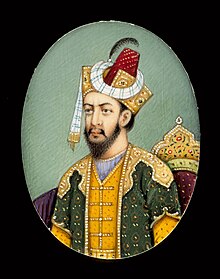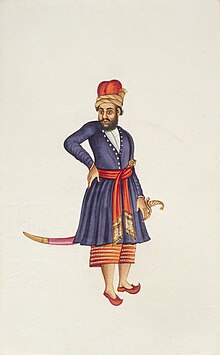This is an old revision of this page, as edited by Hassan Janhal (talk | contribs) at 16:33, 22 December 2022 (Improved article +added images, + added links and references). The present address (URL) is a permanent link to this revision, which may differ significantly from the current revision.
Revision as of 16:33, 22 December 2022 by Hassan Janhal (talk | contribs) (Improved article +added images, + added links and references)(diff) ← Previous revision | Latest revision (diff) | Newer revision → (diff) Group of tribes of Turko-Mongol descent in Pakistan and India For the people of Central Asia, see Moghol people. Ethnic group| مُغَل | |
|---|---|
 Portrait of Mughal Emperor Humayun. Portrait of Mughal Emperor Humayun. | |
| Languages | |
| Persian (formerly) Hindustani (Urdu-Hindi), Punjabi, Hindko, Pahari-Pothwari, Kashmiri | |
| Religion | |
| Islam | |
| Related ethnic groups | |
| Mongolic and Turkic peoples |
The Mughals, Moghuls or Moguls (Persian/Urdu: مُغَل; Mongolian: Mogolchuud) are a number of culturally Turko-Mongol tribes in Pakistan and India. They claim descent from the various Central and East Asian Mongolic and Turkic tribes that settled in this region centuries ago. The term Mughal (or Moghul in Persian) literally means Mongol.
History and origin

During the time of the Mongol Empire in the 13–14th century, the army of Genghis Khan swept across Central Asia and into Persia. Over subsequent centuries, descendants of these soldiers inter-married with Persian and Turkic Muslims, converted to Islam and adopted the Persian language and culture. Conflict between South Asia (modern-day Pakistan and India) and the Mongols has been recorded from the time of Genghis Khan to Timur to Babur. The Delhi Sultanate (1206–1526) faced nearly annual Mongol onslaughts from 1297 to 1303 when the Doab was sacked and what is now Pakistan was under continual Mongol occupation. Indian and Indo-Persian sources referred to the invaders as Mughals, derived from the word Mongol. During the 16th century, the Turko-Mongol conqueror Babur brought most of northern India under Mughal rule, establishing an empire that would endure until the mid-19th century. As the ruling class, the Mughals lived mainly in cities along with other Muslims. They were traditionally known for their skill at horsemanship, archery, wrestling and a meat-heavy diet.

The court itself does not now consist, as originally of real Mongols, but a medley of Turks, Turkman/Uzbeks, Arabs and Persians or descendants of all these classes; known, as said before by the general appellation Mughal by the Muslims of native origin.
As early as the 17th century, the term Mughal covered a large number of groups. Generally, all Central Asian immigrants to South Asia, whether Uzbek, Chughtai or Gürkani Türks, further Timurids, Barlas, Kipchak, Kazakhs, Turkman, Kyrgyz, Uyghurs or Mongol, were referred to as Mughal. The term was also used for later immigrants from Iran and Turkey, such as the famous Qizilbash community.
In North India, the term Mughal refers to one of the four social groups that are referred to as the Ashraaf in Pakistan, a number of tribal groupings such as the Tanoli in North West Frontier Province and the Gheba and Kassar in Punjab claim Barlas Mughal ancestry. Sir Denzil Ibbetson, the eminent British student of Punjabi tribal structures, noted a tendency among many tribes of the Pothohar and Upper Hazara regions of Northern Pakistan to claim Barlas Mughal ancestry.
Mughal Tribes
- Kassar Mughals
- Kamangars
- Chughtai Mughals
- Tanolis
- Gheba Moghols
- Barlas Mughals
- Ogahis
- Janhal Mughals
- Hoteel Mughals
- Douli Mughals
In Pakistan
In Kashmir
The Mughal tribe in Azad Jammu and Kashmir include Kamangars and Kassar Mughals. The word Kamangar is derived from two Persian word Kam and Ghar which means Bow makers. As a community, they are in essence village artisans, who are now involved mainly in the manufacture of pots and pans. They were originally bow makers before the arrival of British in the 19th Century.They Live mainly in the Pooch, Bagh and Mirpur districts of Azad Kashmir. The Kassar Mughals are one of the three major land-owning tribes in the Dhani country of Chakwal District in Punjab, Pakistan. Their lineage is connected with the Mughal Emperor Babur in the 8th generation and showed their ancestor Kassar as a distant cousin of Babur.
In Hazara

The Tanolis are a Barlas Mughal tribe living mostly in the Hazara area of Khyber Pakhtunkhwa, Pakistan. They form the majority of the population of Lassan Nawab union council. They have two major divisions, namely Palaal (پل آل) and Hindaal (ہند آل). Majority of the Tanolis today speak Hindko language. The Princely states of Amb and Phulra were ruled by the aTanolis for centuries.
In India
In North India
In North India, the term Mughal refers Gürkani Türk or Timurids. A single root family origin from Chagatai Türk named after Chagatai Khan. But one of the social groups that are Claim to as the Ashraaf.
In Uttar Pradesh

In Uttar Pradesh (UP), their main clans are the Chagatai Turks, Gurkānī or Timurids, Barlas, Qazilbash, Turkmen, Turk, Uzbek, Kayı. The Mughals of Uttar Pradesh belong to the Sunni sects, with the majority belonging to the Sunni Hanafi sect. Sunni Mughals are usually orthodox in their religious outlook. The Mughal of Awadh trace their entry into the region to the year 1750. The Mughal of UP are an endogamous community, marrying within their own community, or in communities of a similar status such as the Syeds, Shaikh (Siddiqui, Farooqui, Usmani, and Nomani etc.), Pathan, Shamsi, Kidwai and Muslim Rajput. Some of these group immigrated to Uttar Pradesh, India as early as 1200 AD during the Delhi Sultanate. The rural Mughals are farmers, and many own orchards, especially mango orchards, while in towns they are engaged in trade, handicrafts. Carpet weaving is an activity particularly associated with the UP Mughals.
Present circumstances
The Turks or Gurkanis or Mughals live in northern India, mainly in Delhi, Ghaziabad, Amroha, Moradabad, Rampur, Sambal, Bijnor, Muzzafer Nagar and Meerut in UP. They also are in Udhamsingh Nagar, Nainital, Haldwani and Dehradun in Uttrakhand, Bhopal, Junagarh in Gujarat.
The community had traditionally served as soldiers in the armies of the various Turkic dynasties which ruled Indian subcontinent. They were and still are a community of small to medium-sized farmers. A good many are also traders. Like other Gujarati Muslims, they have a caste association known as the Jamat, which acts both as a welfare organization and an instrument of social control.
See also
References
- Munshi Muhammad Din Fauq's Tareekh Aqwam Poonch
- A Glossary of the tribes & castes of Punjab bu H. A Rose
- ^ Dictionary Of Geography. Wisconsin: Houghton Mifflin. 1997. ISBN 0-395-86448-8.
- A Glossary of the tribes & castes of Punjab bu H. A Rose
- Сабитов Ж. М., Баймуханов Н. Б. (2015). "Y-STR гаплотипы узбеков, уйгуров, таджиков, пуштунов, хазарейцев, моголов из базы данных Family Tree DNA" (in Russian) (2) (The Russian Journal of Genetic Genealogy ed.): 22–23.
{{cite journal}}: Cite journal requires|journal=(help)CS1 maint: date and year (link) - Liz Wyse and Caroline Lucas (1997). Atlas Of World History. Scotland: Geddes & Grosset.
- Collins Compact Dictionary. Glasgow: HarperCollins. 2002. ISBN 0-00-710984-9.
- Bernier's Travels in the Mogul Empire (Paperback) by Francois Bernier Constable 1891
- John Keay (2000). India: A History. New Delhi: HarperCollins. ISBN 0-00-255717-7.
- 1881 census of Punjab
- Khan, Shahrukh Rafi; Khan, Foqia Sadiq; Akhtar, Aasim Sajjad (2007). Initiating Devolution for Service Delivery in Pakistan: Ignoring the Power Structure. Oxford University Press. ISBN 978-0-19-547221-9.
- Allen, Charles (2012-06-21). Soldier Sahibs. John Murray Press. ISBN 978-1-84854-720-9.
- Muslim Caste in Uttar Pradesh (A Study of Culture Contact), Ghaus Ansari, Lucknow, 1960
- People of India Gujarat Volume XXI Part Three edited by R.B Lal, P.B.S.V Padmanabham, G Krishnan & M Azeez Mohideen pages 1394-1399
| Mongolic peoples | |||||||||||
|---|---|---|---|---|---|---|---|---|---|---|---|
| History | |||||||||||
| Proto-Mongols | |||||||||||
| Medieval tribes | |||||||||||
| Ethnic groups |
| ||||||||||
| See also: Donghu and Xianbei · Turco-Mongol · Modern ethnic groups Mongolized ethnic groups.Ethnic groups of Mongolian origin or with a large Mongolian ethnic component. | |||||||||||
| Turco-Mongol | |
|---|---|
| States | |
| Related ethnic groups and clans | |
| Culture | |
| Origin is controversial. | |